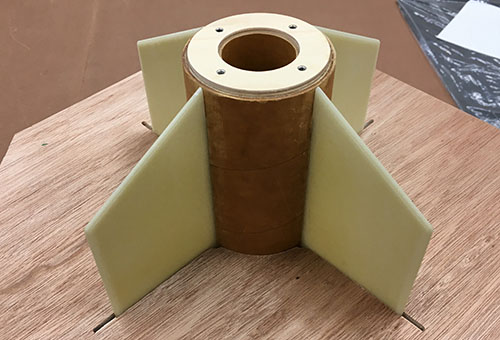Trying to achieve better than 1/100th inch accuracy with hand tools is pretty ambitious. I.e., this is measuring to 1/128" (or 0.25mm).
As you say, the traditional method is using a piece of aluminum L channel, which naturally lines up with the tube axis for marking. But I doubt that's going to be more accurate than what you state.
I'm not sure it matters for most rockets. As long as the error is randomly distributed, it shouldn't cause excessive roll. (And roll only really matters for camera rockets anyway.)
I have been experimenting with using a CNC router with a 4th axis for slotting tubes. It'll be interesting to see if this produces a better result. (My concern is that the error will not be random, even though smaller, and may actually induce more roll.)
For most people, I would agree, however, I am quite comfortable in working at a very high level of precision, and have been for many years. My shop is well equipped with precision ground granite plates, calipers, micrometers, height gauges, depth gauges, dial indicators, bore gauges, etc. On a wood product that I have made well over 1000 of at this point, I routinely expect some tolerances to be under 0.0015", and will work the piece until I am there, but often see tolerances within 0.0005"of what I spec for with minimal tuning. Other tolerances on the same piece, have to be held under 0.005" or the piece is a 'second'. This is in terms of 'absolute precision' where the work interfaces with a metal piece of known and consistent dimension, as opposed to 'relative precision' where asometimes a looser set of tolerances will allow for 'precision relative to non critical neighboring components. I recognize that this is an anomaly in woodworking, and it requires some highly specialized processes.
In the machine shop, I do a lot of high precision bearing work, and am used to measuring in 'tenths'.
With a router in a properly built jig, holding a tolerance of 0.001" should be no problem, I do it all the time. Challenges that I see in routing a precise slot in a fiberglass tube are: holding the tube so that vibrations from the cutting action of the bit cause zero rotation (solved), and establishing all the planes in setting up the guides so that the router travels purely paralell to the axis of the tube. The plunge is less than 0.100", so there may be some very slight 'excess cut' at the bit entry point, but once the bit is plunged, it should be no problem to cut straight. Certainly straighter than 0.010'. In 5" that is a lot! That would be a lot for a plywood panel cut on a table saw.
As for the question of 'if it matters', I answer that everything matters. Straight slots will not cover for warped or otherwise imprecise fins, or problems elsewhere, but there is probably no harm in straight slots. In most everything, better is better. And, for me, creating things is a form of self refinement. If I am not doing my best work, why not? Most often, it takes little more time to 'do your best'.
I wish I had a CNC router in my shop! I have access to one, but am still learning Fusion 360 and some other software.









